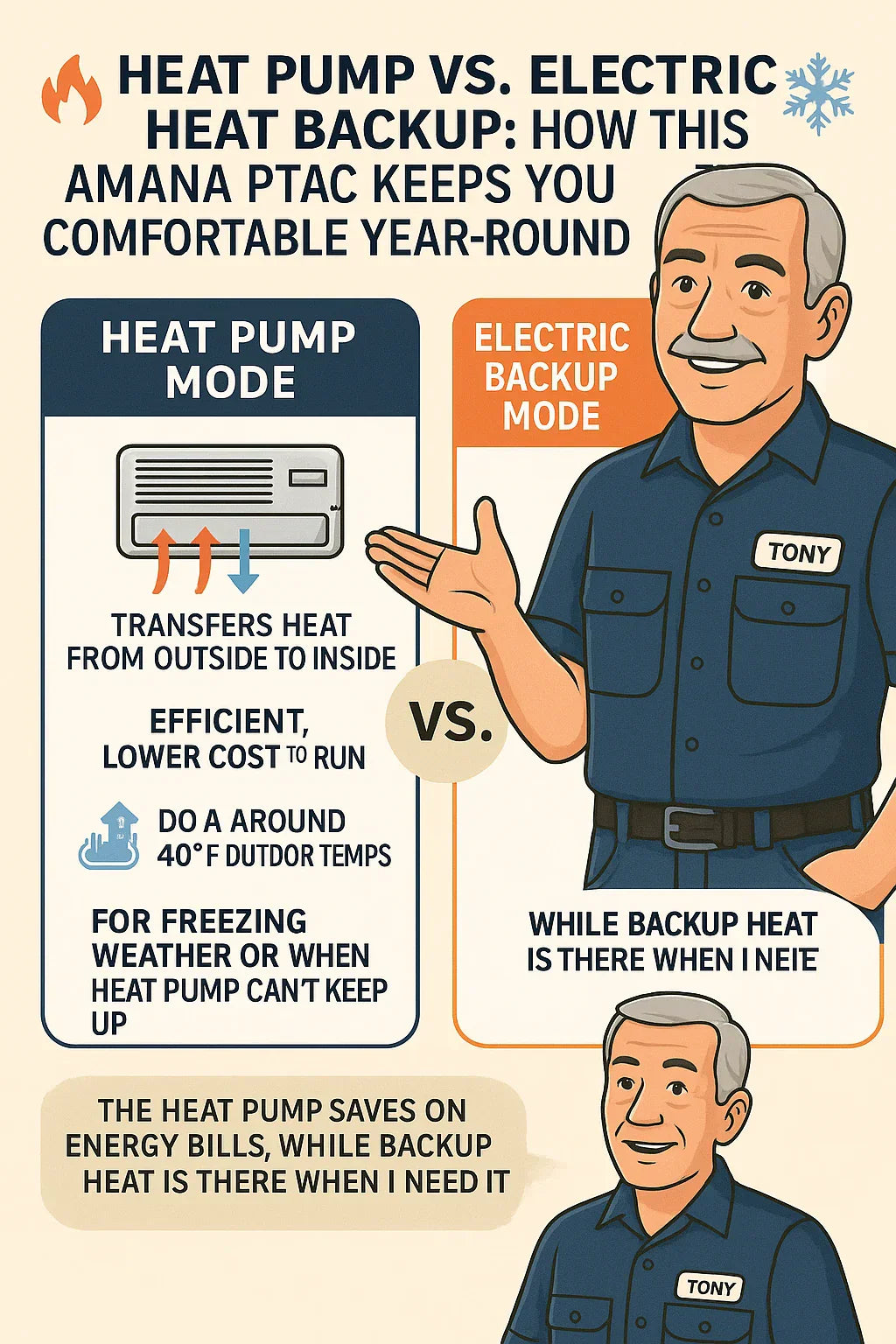When Tony started shopping for a new PTAC (Packaged Terminal Air Conditioner) to replace the old unit in his guest apartment, he faced a choice: Should he buy a standard electric heat PTAC or invest in one with a heat pump plus electric backup?
His pick—the Amana Distinctions 12,000 BTU PTAC Heat Pump with 3.5 kW Electric Heat Backup—proved to be the best of both worlds. The heat pump gave him efficient heating and cooling most of the year, while the electric backup provided reliable comfort during cold snaps.
In this guide, Tony breaks down what the difference is, why both matter, and how to decide if this Amana PTAC is right for your room or apartment.
🌡️ Heat Pump vs. Electric Resistance Heat: What’s the Difference?
Understanding the difference is the key to knowing why a dual system matters.
🔁 Heat Pump (Primary Mode)
-
Works like an air conditioner in reverse.
-
Uses refrigerant to transfer heat from outside to inside.
-
Extremely energy efficient because it moves heat instead of generating it.
-
Works best in temperatures above ~40°F.
👉 According to the U.S. Department of Energy, heat pumps can cut electricity use for heating by 30–50% compared to electric resistance heating.
⚡ Electric Resistance Heat (Backup Mode)
-
Uses electric coils to directly generate heat.
-
Works in any outdoor temperature, even extreme cold.
-
Less efficient—basically like running a giant toaster.
👉 While reliable, running only on electric heat can lead to higher utility bills, especially in colder climates.
🏠 Why the Combo Matters in a PTAC
The beauty of the Amana Distinctions PTAC is that it blends these two technologies:
-
Heat pump runs most of the year → efficiency + lower bills.
-
Electric heat activates automatically when needed → guaranteed comfort.
This means:
-
You save money most of the time.
-
You don’t worry about being cold on freezing nights.
-
The system decides when to switch, no manual toggling required.
📊 Real-World Example: Tony’s Guest Apartment
Tony’s space:
-
500 sq. ft. guest apartment
-
Average insulation, 8-foot ceilings
-
Midwest climate (Ohio: warm summers, cold winters)
Performance:
-
Spring/Fall: Heat pump mode kept the apartment at 72°F with low costs.
-
Winter: Heat pump handled most days above 40°F.
-
January: On nights below 20°F, the 3.5 kW electric coils kicked in to keep it cozy.
👉 Tony compared his utility bills with his old electric-only PTAC and saw about 35% savings over the year.
💰 Cost & Efficiency Breakdown
⚡ Heat Pump Mode (Efficient Days)
-
Uses about 1.2 kW per hour in heating/cooling.
-
At U.S. average electricity rate (EIA 2025:
16.2 cents/kWh), that’s **$0.19/hour**. -
Run 8 hours = ~$1.52/day.
🔥 Electric Resistance Backup (Cold Snaps)
-
The 3.5 kW electric coils use 3.5 kW per hour.
-
That’s ~$0.57/hour, or ~$4.50 for 8 hours.
Since Tony only needed backup heat for 10–15 days in January/February, his annual cost remained low.
👉 Compared to running electric-only heating all winter, he saved hundreds per year.
🌎 How Climate Impacts the Balance
Whether a heat pump + backup PTAC is worth it depends on where you live.
✅ Best Fit for Heat Pump PTACs
-
Mild or moderate climates (South, coastal, Southwest).
-
Where winter temps rarely dip below 40°F.
-
You’ll use the heat pump almost 100% of the time.
⚠️ Backup Heat Matters In:
-
Cold climates (Midwest, Northeast).
-
Where winters drop below 30°F frequently.
-
Without backup, you’d end up cold and uncomfortable.
👉 Use Energy Star’s climate map to see how a heat pump works in your region.
📐 Sizing Considerations: Why 12,000 BTUs Works Well
The 12,000 BTU rating of the Amana Distinctions PTAC makes it ideal for:
-
Rooms/apartments 450–550 sq. ft.
-
Standard ceiling heights (8 ft.).
-
Medium occupancy (1–2 people).
👉 Check the DOE’s AC sizing chart to confirm BTUs for your square footage.
🔊 Noise Levels: Heat Pump vs. Electric Heat
One question Tony had: Would switching between modes mean more noise?
-
Heat pump mode: Runs around 45–50 dB, like quiet conversation.
-
Electric coils: Silent—only the blower fan makes noise.
-
Switching: Seamless, barely noticeable.
Compared to his old window unit, the Amana PTAC was far quieter.
🛠️ Maintenance Tips for Dual-Mode PTACs
Keeping your PTAC running efficiently is simple:
-
Monthly: Clean or replace filters.
-
Every 6 months: Vacuum coils (inside & outside).
-
Check condensate drain: Prevent leaks/mold.
-
Annually: Inspect electric heat coils for dust buildup.
👉 See Amana PTAC Maintenance Guides for best practices.
🧮 Cost Comparison: Heat Pump + Backup vs. Electric-Only
| Feature | Heat Pump + Backup (Amana Distinctions) | Electric-Only PTAC |
|---|---|---|
| Efficiency | ✅ 30–50% lower heating bills | ❌ High bills in winter |
| Comfort | ✅ Reliable in any weather | ⚠️ Struggles below freezing |
| Upfront Cost | ~$200–$300 more | Slightly cheaper |
| Best Use | Year-round climates | Warm climates only |
👉 Tony realized the slightly higher upfront cost was paid back in just 1–2 winters thanks to energy savings.
🎯 Final Verdict: The Best of Both Worlds
A 12,000 BTU PTAC with heat pump + 3.5 kW backup electric heat like the Amana Distinctions model gives you:
✅ Efficient cooling in summer
✅ Cost-effective heating most of the year
✅ Reliable electric backup when it’s freezing
✅ Year-round comfort without worrying about climate limits
Tony puts it this way:
“If you only buy an electric PTAC, you’ll pay more in bills. If you only buy a heat pump PTAC, you’ll freeze on the coldest nights. With both, you’re covered all year—comfort and savings in one package.”
In the next topic we will know more about: PTAC vs. Mini Split vs. Window Unit: Which System Is Right for Your Space?







